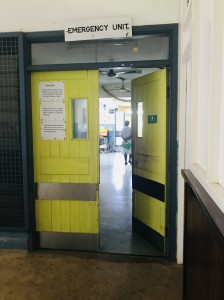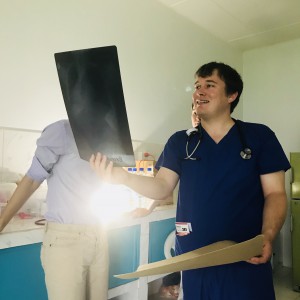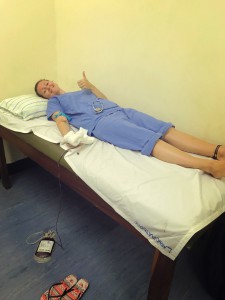Arriving on the beautiful island of Santo Espiritu in Northern Vanuatu I was ready to hit the ground running and submerge myself in my first elective placement. I could already tell by the flight over the island that I was in for an interesting month here. The buildings were mostly concrete block with tin or palm roofs and the main centre of Luganville was tiny (even by New Zealand standards). The main industries on the island seem to be farming, fishing and tourism with the former two grinding to a halt for the latter when the cruise ships arrive in port.
My classmate Sam was already in the area and showed me the ropes including how to find the hospital. The Northern District Hospital is set on a hill next to the prison and looks out over Luganville and the surrounding islands. On coming up the gravel track, more pot holes than road, to the worn-out block hospital with peeling paint and you are immediately struck by the condition of healthcare here. The buildings are solid but basic with patients 4-8 per room and no privacy curtains. Families crowd in around the beds and bring their own woven mats to lie on overnight. They provide the meals for their sick family members and comfort when the over stretched nurses cannot. Air-conditioning is provided only in the operating theatre, delivery suite, pharmacy and the private (paid) rooms. While I was still adjusting to the heat this made ward rounds tough and I would often have to head to the doctor’s area to sit down and sip some water.
Although I was mostly based in O&G (more on this in a future post!) I took the opportunity to see ward rounds in both general medicine and paediatrics. My placement fell during a dengue fever outbreak and it was not unusual to see cases on the ward. There were also the regulars of Tb, malaria, hepatitis as well as the heart failure and cancers we’d see in New Zealand. Children with Tb lymph nodes required two months of in hospital antibiotics to start the prolonged Tb treatment. The two boys I saw on the ward were otherwise normal healthy children chasing each other around and playing tag. The paediatric ward had no books or toys to distract them and any form of entertainment had to be brought in by the families.
The hospital ran on the very basics of equipment and textbooks we took from donations in NZ were quickly snapped up by the junior doctors. The blood bank ran out and all the elective students pitched in to donate and resupply. Often family members are called on to help with blood donations for emergencies such as during a case of PPH during my placement.
They are in need of so much at NDH that myself and Sam felt we couldn’t leave without doing something more. Sam collected lists of needed equipment from the different wards and a collection is planned. We are also encouraging other elective students to go to NDH and take what they can.
A give-a- little page has been set up to help with costs of shipping to the hospital and those that want to donate can do so here.




No comments yet.
Leave a comment